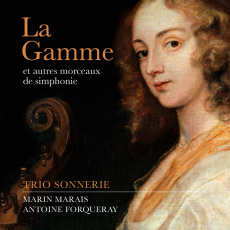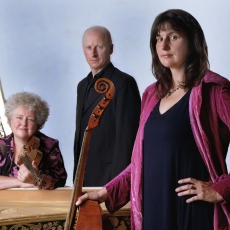Trio Sonnerie - La gamme - VdGSA Journal
Marais' five books of pieces for solo viol and continuo, published between 1686 and 1725, comprise a monumental life's work. The pieces are invaluable for study, as Marais included careful markings for fingerings, bowings and expression. In 1723, five years before his death, Marais published quite a different volume: La Gamme et autres morceaux de simphonie pour le violon, la viole et le clavecin. Included in this book of chamber music are La Gamme (The Scale) en forme de petit Opera, a massive work of 36 pages without a pause; Sonate a la Maresienne; and the well-known work generated from a three-note ground bass, Sonnerie de Ste Genevieve du Mont de Paris. This entire book of music and the first suite by Forqueray make up the brilliant new CD by Trio Sonnerie.
La Gamme is a piece that demonstrates Marais' total mastery of harmony as he effortlessly and imperceptibly glides up and then down the scale. Though he calls it a petit opera, it has no obvious program but is continuous music in many sections. There are long solos for each of the two string instruments, duets without continuo, and some solo harpsichord introductions. The performances by Trio Sonnerie are virtuoso and always supremely tasteful.
Much of the score of La Gamme is written with each instrument on its own line, and while it is clear when the violin enters, the gamba part alternates from the solo part in a trio configuration to passages where it joins the bass. Marais sometimes has an ornamented bass line just for the viol, but here the performers have decided when to give the viol a rest during some long violin passages, which makes for a variety of colors in a 35-minute piece. When both string parts are serenading in a high register it might have been helpful to have reinforcement on the bass line, mainly because the bass line relentlessly pushes through the key changes.
Live performances of the piece are rare, the length being so out of proportion to any other movement by Marais; the nearest, the Labyrinthe, is ten minutes. The Linn recording is a great performance of a tour-de-force piece, and it is recommended that you listen with the facsimile edition (Performers' Facsimile, 49, New York, 1988, no. 2787) in front of you, to follow how Marais gently invites us through the keys of the scale.
The Sonate a la Marsienne is also fairly continuous, but remains almost entirely in the key of C. The sections are more clearly delineated, and though French dance movements are indicated, it feels like Italian music. Violinists must enjoy getting to play Marais, and gamba players get to play an Italian bass line even more exciting than Corelli's.. The musicians of Sonnerie expertly navigate the rapids. Where the piece goes into C minor, a beautiful Gravement doux, Marais wrote one of the longest crescendos in all his music, which might have been more dramatically done on the recording.
With a name like Trio Sonnerie, it is clear that the players know every inch of Sonnerie Ste Genevieve du Mont de Paris, and the performance is in expert hands. The CD concludes with the first suite of Forqueray, alternating between the solo viol and harpsichord versions. It is a good way to perform the piece, satisfying to all listeners.


